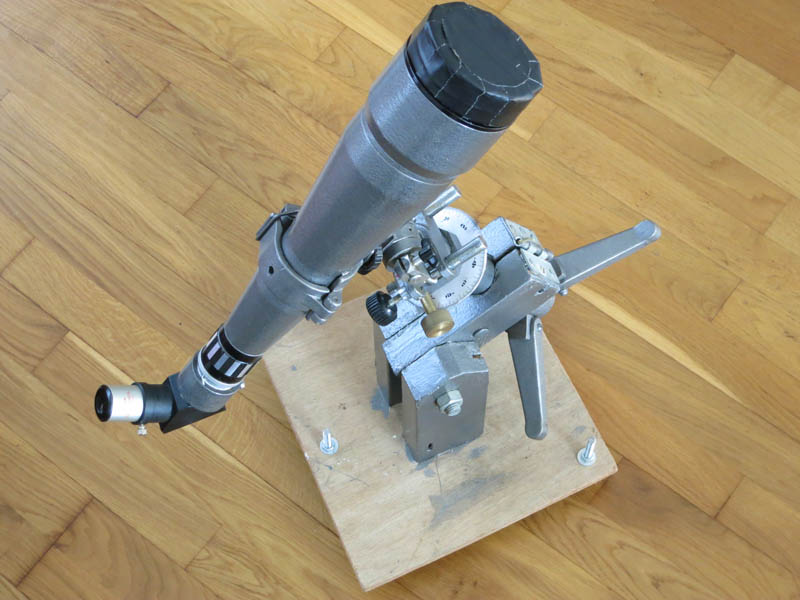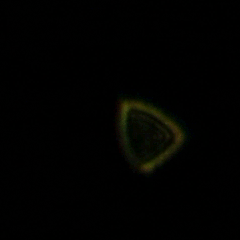- Index page with recent astrophotos
- Leeuwenboschfontein weekend starparty 2016 Mar 4-6
- Events observed by me from 2003 latest: Mercury transit 2016 May 9
- Page with sky pictures with the EOS 6
- Lunar and planetary images and phenomenas
- Page with sky pictures with the EOS 40 from Bali jan 2009, feb 2010 and 2012
- Page with sky pictures from La Palma Jan / Feb 2011
- Total lunar eclipse of 2011 Jun 15
- Solar eclipse visible as deep partial in Indonesia on 2009 Jan 26
- > Old 1973 Polarex 80mm spotting scope refurbishment.
- New 2015 Robtics ED110 refractor
- Using a telephoto lens as a small handheld telescope
- Nice sky pictures taken from a plane in full flight
- How to see stars in the daytime ?
- Old astrophotos from 1980-1990s
- How I learned Astronomy
- Astronomik CLS filter test
- Simple Eclipse calculations
Polarex 80mm spotting scope
In 1973 I saw at an optometrist shop in Arnhem (which still exists and is taken over by the son and they still sell scopes, but only from Bresser and Meade) who also sold telescopes, some nice telescopes from Polarex, the most way beyond my budget but I saw two nice ones, both on a tabletop mount: a 70mm and 80mm spotting scope the first for € 127 and the 80mm with slow motion control for € 163. Nice aperture much more than the 50mm I was used to and a turret with four eyepieces for 20, 30, 40 and 60x. Of course I did not expect the quality of the Polarex astronomical telescopes as this telescope is designed for low power use and terrestial obervations (a 'spotting scope'), but that was alo my main reason to use it for wide field deep sky observing.
Surely I observed planets. But I was very happy, much brighter images of the sky, really nice ! On 10 Dec 1973 I observed a small partial lunar eclipse and the noght after an occultation of Saturn.
About 20 years later I modded this scope by replacing the poor quality eyepieces with a 45° Amici prism turret by a 1.25" opening and a standard 1.25" diagonal allowing use of more (and better) contemporary eyepieces. The performance of this scope is OK as long the power does not exceed 80x otherwise color errors become apparent. When I put a Nagler 13mm type 6 (82° apparent angle) the image was really amazing, nearly as good when I put the same eyepiece in my 100mm Televue Genesis ! Also using Vixen Plössl eyepieces gave a dramatic increase in image quality, despite the average performing objective lens. Moreover I adapted the table tripod mount in order to mount the scope on a standard 1/4" - 20 tripod thread and use the original tripod for cameras as well. So I purchased a Vixen Super Polaris mount in 1991 where I put this telescope on sometimes as tracking scope and using the Canon T90 (now the Canon EOS 7D) for astrophotography. It is a convenient small scope of only 1.4 kg which is a very good deep sky performer particularly when a Nagler eyepiece is used.
But, still at powers of 38x or more the triangular spikes are apparent at brighter objects and at higher it is more obvious. I have always had this problem. But in the 1970s I had no idea that this 'haze' around planets was actually an optical error so I accepted it. Actually I could return it to the shop and get a better copy. It was not the crappy Huygens eyepieces as a Nagler with a Powermate 2.5x (96x) shows the same errors. So I decided (June 2012) to do a star test with the same eyepieces as with the Televue Genesis but without Amici diagonal (no diagonal at all). I pointed the scope at Arcturus and used the Vixen LV6mm and the Televue Powermate 2.5x which is a magnification of 210x. While the Genesis showed nice round diffraction rings when defocusing, this scope showed ugly triangular diffraction images which were obviously very tight strain in the lens cell.
I posted this animating image to forums and all replied indeed 'pinched optics' with lots of strain on the lens cell. So I tried loosening the rings over the front lens but to no avail. it was mounted VERY TIGHTLY. Now I decided to replace the objective. There was one 80x480 FPL-53 available at Telescope Service Ransburg near München Germany for € 440 but it has a very long (> 3 months) delivery time. So I put an ad on a Dutch astronomy products trading mart and by surprise, the next day I got a reply from a guy 20km from here who had a good 80x500 achromat for only $25. Same focal length. So for that price I got it and it turned out to have an excellent quality, both mechanical and optical. I did a test run by mounting it temporarily on the telescope tube with duct tape (!) and even at 210x the images were unexpectedly razor sharp, but as expected blue halos around it. I tested it side by side with a Televue Genesis at 210x power and it turned out that the images on tis scope were as sharp as the Genesis but the Genesis was (obviously) brighter ( (10cm / 8cm )2 = 1.56x) and lacked the blue halos. But the blue halos were not really annoying. From now on this telescope gets a real astronomical telescope. So I decided to let somebody I know from Astrotechniek in Velden near Venlo to make an adaptation ring to mount the objective on the scope. The guy from Astrotechniek said it has an excellent mechanical quality with an iron containing alloy in the lens cell (a magnet sticked on it). 'It should have been a part of an expensive optical device built in the 1980s' he said. It is definitely not a so-called RR (Rainpipe refractor) objective which were imported by Hans Winkelaar of Sky Objectives from China / Taiwan in the early 2000s.` After slightly more than a week it was ready: a nice lathed aluminum ring which fits perfectly. Only thing: it had 3cm too much backfocus so I have to use a 1.25" rear tube extender to get focus. But that saves weight. Despite the rather heavy objective and solid aluminum ring the OTA weight increased only from 1.4 to 1.6 kg. Now I pained the inside of the ring with black matte stove spray (Hammerite 'High Temp') which made the inside excellently black matte as it should on the inside of telescope tubes.
The vertical movement (altitude) is somewhat problematic when pointing high in the sky. As the table mount is designed for terrestial use (as it was a 'spotting scope'), when pointing high in the sky it tends to topple backward and can only be boved by unscrewing the vertical fix screw, moving and screwing it. | ||||||||||||||||||||
Images | ||||||||||||||||||||
|
The telescope fits in its original cabinet with extra eyepieces : Vixen LV6, Televue Nagler 13T6 and Televue Panoptic 24. Furthermore a Baader Amici prism.
Still to be done:
| ||||||||||||||||||||




